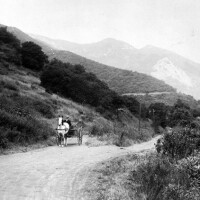Restoring Griffith Park on the East Bank of the Los Angeles River

The 28+ acre site of Griffith Park on the East Bank of the Los Angeles River should be the next great urban park in Los Angeles. Councilmen Tom LaBonge and Ed Reyes recently introduced a motion to have the city Recreation and Parks Department, Bureau of Sanitation and Bureau of Engineering do a study to determine "what land . . . might be available along the eastern bank of the Los Angeles River to create open space."
The people have already done such a study to jump start the greening of the L.A. River.
Picture a bucolic stream, a tree-shaded picnic area, a path for walkers and equestrians, a playground for little ones, and athletic fields to enjoy soccer and other organized sports. Now picture it all in an easily accessible area of Griffith Park near working class families with a stunning view of the hills and river.
Is it a pipe dream? No. It's what happens when the community recognizes that public enjoyment of Griffith Park can be expanded, without the purchase of new parkland, and that the culture of Los Angeles has changed so that the Los Angeles River can no longer be treated as an industrial wasteland.
Griffith Park on the East Bank of the L.A.River is already parkland that the city is using for a service yard. The site can be restored as a real park in a park poor community. No one needs a service yard on prime riverfront land.
Diverse allies have a conceptual plan that includes a balanced park with active and passive recreation. Scenic pathways and trails allow for exercise and relaxing for individuals and families. Playing fields, interpretive learning spaces and public art enhance the park. All of these uses can be accommodated with the right leadership and sensitive planning that takes into account the needs of all users.
The conceptual plan presents three design alternatives, as illustrated in the renderings. Alternative I envisions one big park totaling 26.78 acres, including the Los Angeles Glendale Water Reclamation Plant on the north side. Alternative II is the same as Alternative I, without the water reclamation plant, totaling 25.5 acres. Alternative III is a River Front Esplanade totaling 1.7 acres. The restoration can start right now, today, with the River Esplanade in Alternative I, for example, then extend to Alternatives II and III over time. A short time.
Within one mile of the site east of the river, there are .8 acres of open space per 1,000 residents. 40.8% of the people are Hispanic, 21.7% other, 18.0% Asian, and 16.9% non-Hispanic white. 20.3% live in poverty.

Many people and groups have contributed to the conceptual plan, including The City Project, landscape architect Ulises Diaz and Studio Dos ó Tres, Prof. Stephen Koletty's geography class at USC, GreenInfo Network, Anahuak Youth Soccer Association, Griffith Park Draft Master Plan Working Group, Northeast Trees, and community leaders. The plan has benefitted from comments received from the Santa Monica Mountains Conservancy (which funded the study); Friends of the Los Angeles River (FoLAR); Harry Chandler, Chair, Los Angeles River Corporation; City Councilman Tom LaBonge; City of Los Angeles, L.A. River Ad Hoc Committee; and Carol Armstrong, Los Angeles River Special Project Office.
The City of Los Angeles published the report "Los Angeles River Access and Use: Balancing Equitable Actions with Responsible Stewardship." The report emphasizes:
Numerous local organizations have stressed the importance of making sure that the river's revitalization addresses environmental justice issues (See, e.g., the City Project's work at: www.cityprojectca.org). Of key concern in Los Angeles is the growing disparity of access to and use of open space resources, including parks, ball fields, and natural areas by those living in low income communities of color; whole generations are growing up in Los Angeles without any meaningful relationship to the natural environment. The river offers an opportunity to redress environmental justice problems by not only providing numerous new green spaces, but also by ensuring free access to them.
Griffith Park on the East Bank of the L.A. River provides such an opportunity.
The New York Times has called the revitalization of the Los Angeles River a best practice example for how the nation can create "more sustainable, livable and socially just cities." (Nicolai Ouroussoff, "Reinventing America's Cities: The Time is Now," N.Y. Times, March 25, 2009.) Griffith Park on the East Bank of the L.A. River offers such a best practice example.
President Barack Obama has designated the greening of the Los Angeles and San Gabriel Rivers as one of the top 101 priorities across the nation for his America's Great Outdoors initiative, out of only two per state. The Department of Interior has also named the L.A. River one of seven urban waters priorities across the nation. New York City has created the 32 mile Manhattan Waterfront Greenway and High Bridge Park along the Hudson, East and Harlem Rivers in the amount of time L.A. has been studying what to do. Madrid has created the world class Parque Madrid Río in that time too.
Let's do it, let's show the nation and the world L.A. create a multibenefit park and clean water project on the river, too, and in record time. Great cities need great parks.
Today in the city of Los Angeles, children of color living in poverty with no access to a car have the worst access to parks, and schools with five acres or more of playing fields, and suffer disproportionately from obesity and diabetes and at risk behavior including gangs, crime drugs and violence. Similar patterns hold true for nine counties of Southern California studied to date. Places to play like Griffith Park on the East Bank of the L.A. River can help change all that.
Griffith Park on the East Bank of the Los Angeles River furthers the vision for equal justice, democracy and livability for all along the River and beyond.


